GA Serves America: Back to life
A fight to save Maine’s rarest trout
Sikorsky seminars
Igor I. Sikorsky III holds an annual seminar at his Bradford Camps, in honor of his illustrious grandfather—inventor of the helicopter and a noted aircraft designer. The seminar includes photos, lectures, artifacts, books, and videos about this pioneer aviation giant. Details are available on the website.
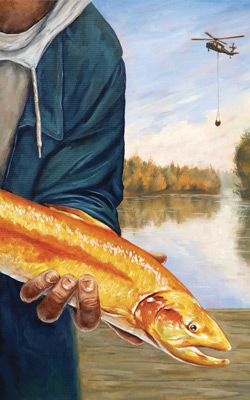 This past fall, the state of Maine “killed” one of its most pristine, isolated wilderness trout ponds in order to save it. Seaplanes (and two Black Hawk helicopters) played a necessary, vital support role in making it possible. And doing the bulk of the day-to-day flying during the operation was Igor Sikorsky III, the grandson of an iconic figure in aviation history.
This past fall, the state of Maine “killed” one of its most pristine, isolated wilderness trout ponds in order to save it. Seaplanes (and two Black Hawk helicopters) played a necessary, vital support role in making it possible. And doing the bulk of the day-to-day flying during the operation was Igor Sikorsky III, the grandson of an iconic figure in aviation history.
The operation began early in September 2010. The remoteness of Maine’s 90-acre Big Reed Pond meant seaplanes and helicopters were the only feasible means of ferrying supplies in and out. Chief Warden Pilot Charlie Later of Maine Inland Fisheries and Wildlife flew loads of lumber strapped to the pontoons of his Cessna 185 to Big Reed Pond to construct a landing dock for receiving supplies. He flew three flights to haul the lumber, which was used to build a 12-by-12-foot platform near the shore. Warden Pilot Daryl Gordon and Later flew some 18 to 20 missions, carrying generators, boats, motors, nets, and other gear.
Sikorsky handled the daily transport of personnel and lighter equipment in his Cessna 172 Skyhawk seaplane. Two Maine Army National Guard helicopters (Sikorsky Black Hawks) did the heavy hauling of the 11,400 pounds of special chemicals required to reclaim the pond. The project leader, biologist Frank Frost, said it took eight chopperloads to fly in the chemicals, which were in crates and slung under the helicopters in rope slings. A crew unloaded the slings on the platform.
The mission to apply the chemical pesticide, Rotenone, was similar to a military operation. It involved biologists and their support staffs from all of Maine’s fisheries regions plus many volunteers, some 25 in all. Since there are only two small, primitive fishermen’s cabins at Big Reed, most of the personnel had to be housed some distance away and flown in and out daily. Exacerbating the situation was the fact that this took place in the fall, when adverse weather is a constant threat in northern Maine.
First, some background
Since the ice age, Big Reed Pond, in the northern Allagash wilderness region of Maine, has harbored populations of three species—and three exclusively—of fish, which have coexisted harmoniously: northern redbelly dace; brook trout; and the rarest of all, arctic char. The dace and brook trout are commonly known, but the char—aka blueback, golden, or sunapee trout—are rare gems. Although populations of char occur globally in the northern climates, none are found below the forty-fifth parallel, and Maine has the world’s southernmost population. In fact, it is the only Lower 48 state to still contain a sustaining population. Char are found in only 12 of Maine’s estimated 6,000 lakes and ponds, and all are remote or inaccessible.

Now that population is threatened with extinction, requiring drastic intervention: chemically “sterilizing” the pond and restocking it with captured native fish.
Big Reed Pond would seem almost invulnerable: Located some 50 miles from the nearest settlement, at the center of a nearly 5,000-acre virgin forest refuge owned—and zealously guarded—by The Nature Conservancy, it has been known to, and visited over the years by, relatively few anglers who came by floatplane or primitive hiking trail to sample its unique fishery. During that period of light fishing, it has continued to produce healthy populations of trout and char—until disaster struck in the form of an “alien invasion.”
Arctic char, while at first glance similar to brook trout, sport flaming orange fins and, especially during the fall spawning time, assume a rich, orange-yellow pigmentation on their sides and bellies, which has earned them the name of golden trout. While they often share the same waters and similar environmental requirements—clean, cool, well-oxygenated—the brook trout, Salvelenus fontinalis, occupy the shallower to mid-levels, while the char, Salvelenus alpinus, prefer the deeper, cooler waters. (The dace, locally called chubs, stay in the shallows and offer little or no space competition.)
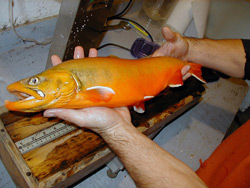 Arctic char match their surroundings in the gorgeous autumn in Maine with flaming orange fins and orange-yellow bellies.
Arctic char match their surroundings in the gorgeous autumn in Maine with flaming orange fins and orange-yellow bellies.
During the 1990s, the populations—especially of the char, but also brook trout—were noted to decline drastically. From an estimated population of some 600 char in Big Reed in 1993, the number dropped to perhaps fewer than 30 in 2009. Brook trout fared somewhat better but not much. The culprit: an illegal introduction of rainbow smelts, Osmerus mordax, to Big Reed’s fragile, vulnerable ecosystem.
What’s wrong with smelts, one might ask? In many of Maine’s larger trout and salmon lakes, smelts are a major forage fish for the larger game fish. But not in a small, delicately balanced ecosystem populated by two trout species that are notoriously sensitive to competition. Arctic char are perhaps least tolerant of all Maine species to competitors—no doubt why they’ve long since disappeared from many waters. Smelts are extremely fecund breeders, and their population simply exploded in Big Reed. As their numbers grew, they not only consumed much of the tiny zooplankton upon which young char and trout rely, but ate the young hatchlings as well. They simply took over the ecosystem.
The smelts most likely reached Big Reed in some fisherman’s bait bucket. Whether inadvertently dumped by an angler at the end of the day, or a deliberate act of illegal stocking, will never be known.
How to help
The Nature Conservancy, which owns and protects the land around Big Reed Pond, has agreed to accept donations towards supporting the trout/arctic char reclamation project at Big Reed Pond. Donations will be used to match federal funds. They are tax-exempt and will be used 100 percent on the Big Reed project. Checks ( write “Reed Pond Project” on check) should be sent to The Nature Conservancy, 14 Maine Street, Suite 401, Brunswick, Maine 04011.
After numerous meetings between department fishery biologists and other interested parties, it was decided to reluctantly take the drastic step of chemically removing all of the fish from Big Reed and restocking again. The simple solution would be to restock from other sources. But that would mean the loss of the endemic strains, native to that specific water.
In 2007, an effort had been made to live-trap both brook trout and char from Big Reed, to hold them in protection at a hatchery and to spawn them in order to produce pure genetic offspring for restocking in the pond. It was fraught with unbelievable difficulties. That year, only one female char and two males were captured. (Live trapping is conducted in the fall, with its unpredictable weather. One of these char had to be hand-transported in a cooler over a trail.) Mated with the two males, only two of this female’s eggs survived. Subsequent matings experienced high mortality percentages—evidence of the fragility and vulnerability of the char.
As if this weren’t difficult enough, it was found that the char kept in a hatchery for future stocking were so wild that they wouldn’t eat the fish food provided for other hatchery trout. They at first would eat only earthworms. Later, they were fooled into eating nutritious fish pellets that were injected into frozen minnows. Finally, they began to thrive on their new diet.
After applying the chemical treatment to Big Reed, the pond will cleanse itself over the next few months. The pesticide, Rotenone (a natural temporary toxin derived from a South American tree and affecting only gill-breathers), acts by restricting oxygen at the fishes’ cellular level. After doing its work, it has a short half-life and becomes ineffective. In fact, not all the trout necessarily die. While chemicals are being pumped into the depths, workers on boats watch for any struggling fish that come to the surface. If caught immediately and placed in fresh water, they can be revived with no harm and flown to a hatchery for future stocking.
Rescue operation
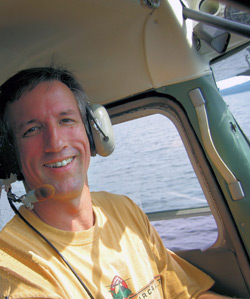 Igor Sikorsky III flies his 1968 Cessna Skyhawk over the lakes and ponds of Northern Maine, where he owns a remote fishing camp.
Igor Sikorsky III flies his 1968 Cessna Skyhawk over the lakes and ponds of Northern Maine, where he owns a remote fishing camp.
Igor I. Sikorsky III owns and operates The Bradford Camps, a fly-in resort on Munsungan Lake, and uses a Cessna 172 Skyhawk seaplane to fly guests in and out. Although nearly 50 miles from the nearest town, Munsungan is about three air miles from Big Reed Pond and The Bradford Camps’ guests have fished Big Reed’s trout for many decades.
Sikorsky says Big Reed has been a “trout factory” in the past, and is confident the efforts will return it to its previous status. “I have flown for the project officially since 2007—close to 100 round trips to Big Reed Pond. Some of the flying is to get personnel in and out of Reed, and some for equipment. The project has required a lot of contortionist, back-breaking work in loading and unloading engines, pumps, nets, 35-gallon barrels of chemicals, and numerous external loads of traps, canoes, and lumber.”
Sikorsky is a 1,000-hour pilot, with 800 of those on floats. “While I come from an aviation family, that is no guarantee that I would become a pilot. I had to learn, like anyone else.” He began taking flying lessons in Lawrence, Massachusetts, in a Citabria. His float training was on the Merrimac River in New Hampshire.
Sikorsky’s airplane is a green 1968 Cessna Skyhawk. It has approximately 1,000 hours total time, and he recently had it upgraded.
“My Skyhawk is a good performer. It might be hard to believe, but I can tell you that it will perform at least as well as a 185 with the same payload in and out of Big Reed. I have a 180-horsepower Penn Yan engine conversion with all the bells and whistles: Power Flow exhaust, polished ports, Hi-Flo air filter, Sportsman STOL kit, plus the big Bauman 2550s [floats]. When my other seats are removed I have an available 995-pound useful load, and she is happy to climb on step with that. Since the pond is close, I can stay light on fuel, and devote lots of that useful load to payload.”
The Skyhawk was perfectly equal to the task of flying in and out of the tight confines of Big Reed Pond. Big Reed Pond is about 3,500 feet long, at an elevation slightly higher than 1,100 feet msl. The best approach is southeast over the outlet. There are no immediate high obstacles.
And in the end
The effort to reclaim Big Reed Pond was intense, rigorous, logistically nightmarish—and very costly for the Maine Department of Inland Fisheries and Wildlife, which is already under financial constraints. According to Fisheries Director Peter Bourque, the total cost “will be very scary.” The chemicals alone cost $36,000. Another $75,000 is contracted to a private hatchery for “culturing” the fish—spawning them and raising the young trout.
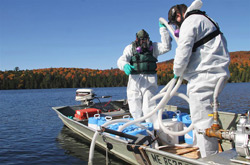 The chemical Rotenone will cleanse Big Reed Pond, which will then be habitable once again for the arctic char, scheduled to be reintroduced to their home this June.
The chemical Rotenone will cleanse Big Reed Pond, which will then be habitable once again for the arctic char, scheduled to be reintroduced to their home this June.
Add in all the other expenses: personnel, transportation, restocking, environmental monitoring for years—and the total will not be known for years. The funds will come primarily from the fisheries general budget and from the Federal Sportfish Restoration program. The department has received a contribution from The Nature Conservancy; the Maine Outdoor Heritage Fund provided grants to support the hatchery work, and some of the captured char are being cared for at the Presque Isle high school.
And there has been “lots of free camp rental and aircraft time from Bradford Camps and other private contributions from Igor’s clientele,” says Bourque. Sikorsky estimates his Bradford Camps will have donated more than $20,000 in flying and cabin services.
In fact, Sikorsky and his wife, Karen, spent hours in a canoe-and-kayak “catamaran” he flew in and put together with lumber and straps, helping to net any surviving fish. No char were found—indicative of the sad state of that population. Forty brook trout were netted, 13 of which were successfully revived in fresh water. They were placed in a special tank with an oxygen system, and flown by Sikorsky to a hatchery.
“I will look very much forward to the monumental day when these fish, and their young, are flown back in their pond this spring,” he said.
Restocking the char is scheduled to begin in June. Brook trout stocking will occur later, to give the char a running start.
Is all of this worth it to save one small, isolated pond and its unique
fish populations? The project’s lead biologist, Frank Frost—and the committee of interested professionals and lay supporters with which he is working—think it is. “I think we caught it just in time…only time will tell now,” he says.
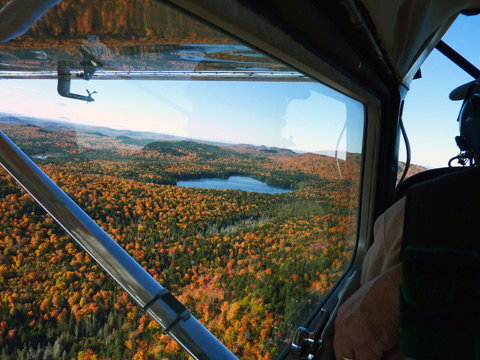
Paul J. Fournier, of Palm Bay, Florida, began flying in 1948. He is a commercial pilot. Illustrations by John Perlock.


